Birds in Massachusetts
Woodpeckers
Most everyone is acquainted with the signature sound of the woodpecker. In the spring and fall, especially, one can hear the distinct sound of a woodpecker drumming or drilling nearby.
Woodpeckers are superbly adapted to life in the trees. Their feet have two toes pointing forward and two pointing rearward with sharp pointed claws. This enables them to scale vertical tree trunks and other vertical surfaces to look for food and shelter.
Their straight pointed bills and reinforced skulls help them to absorb the constant shock of pecking, chiseling, drilling, and drumming. Stiff tail feathers act as props (like a third leg) when the birds climb.
Types of Woodpeckers Found in Massachusetts
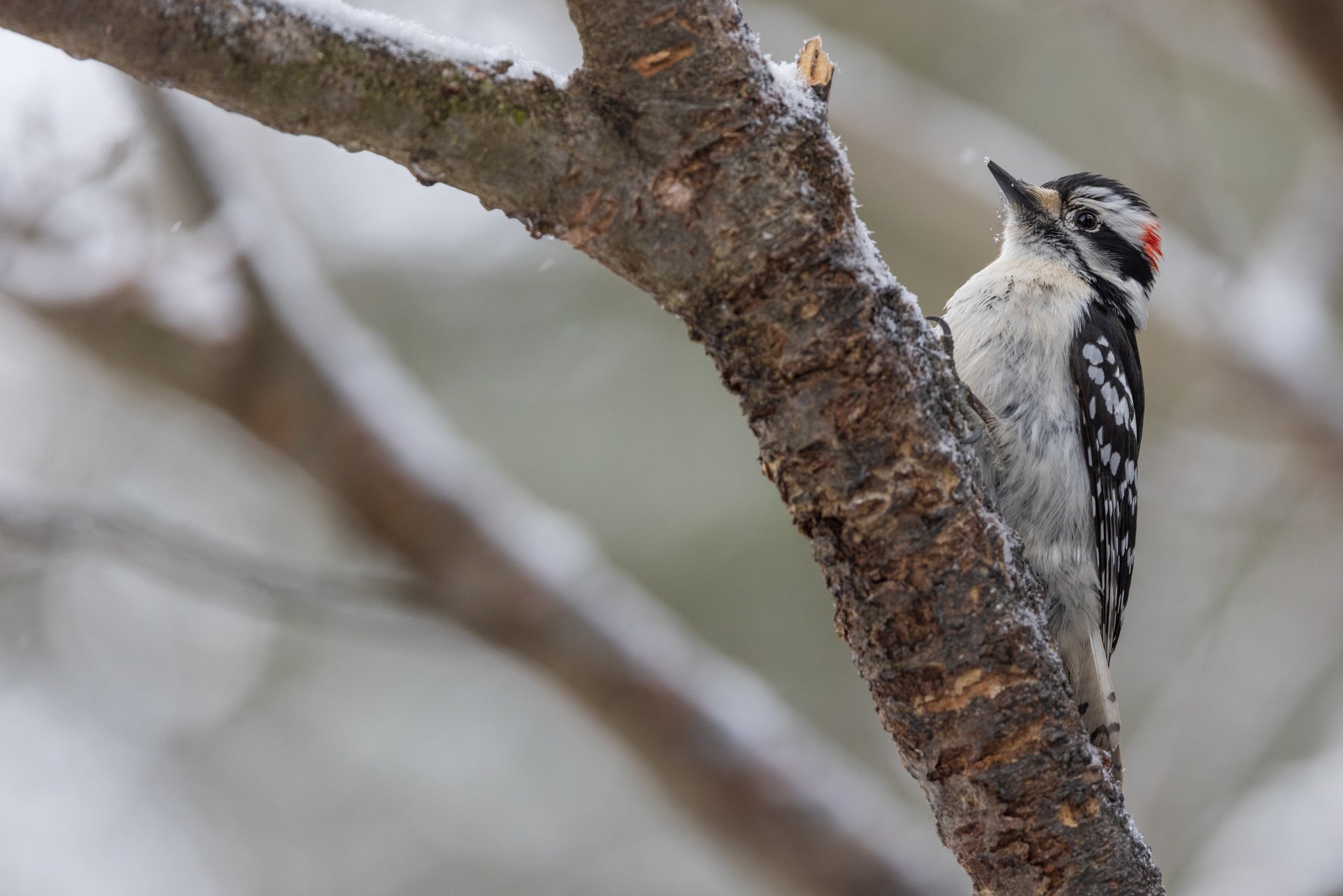
Downy Woodpecker (Picoides pubescens)
This is the most common woodpecker in North America—and also the smallest. It inhabits open woods and urban and suburban areas. This bird eats insects and, less frequently, berries and other plant products, as well as sunflower seeds at bird feeders. It has a black and white checkered pattern, a short beak, and black markings on its outer tail feathers. Its calls include a high peep and a loud rattle; as in many woodpeckers, it drums on trees rather than singing a song. Learn more about Downy Woodpeckers
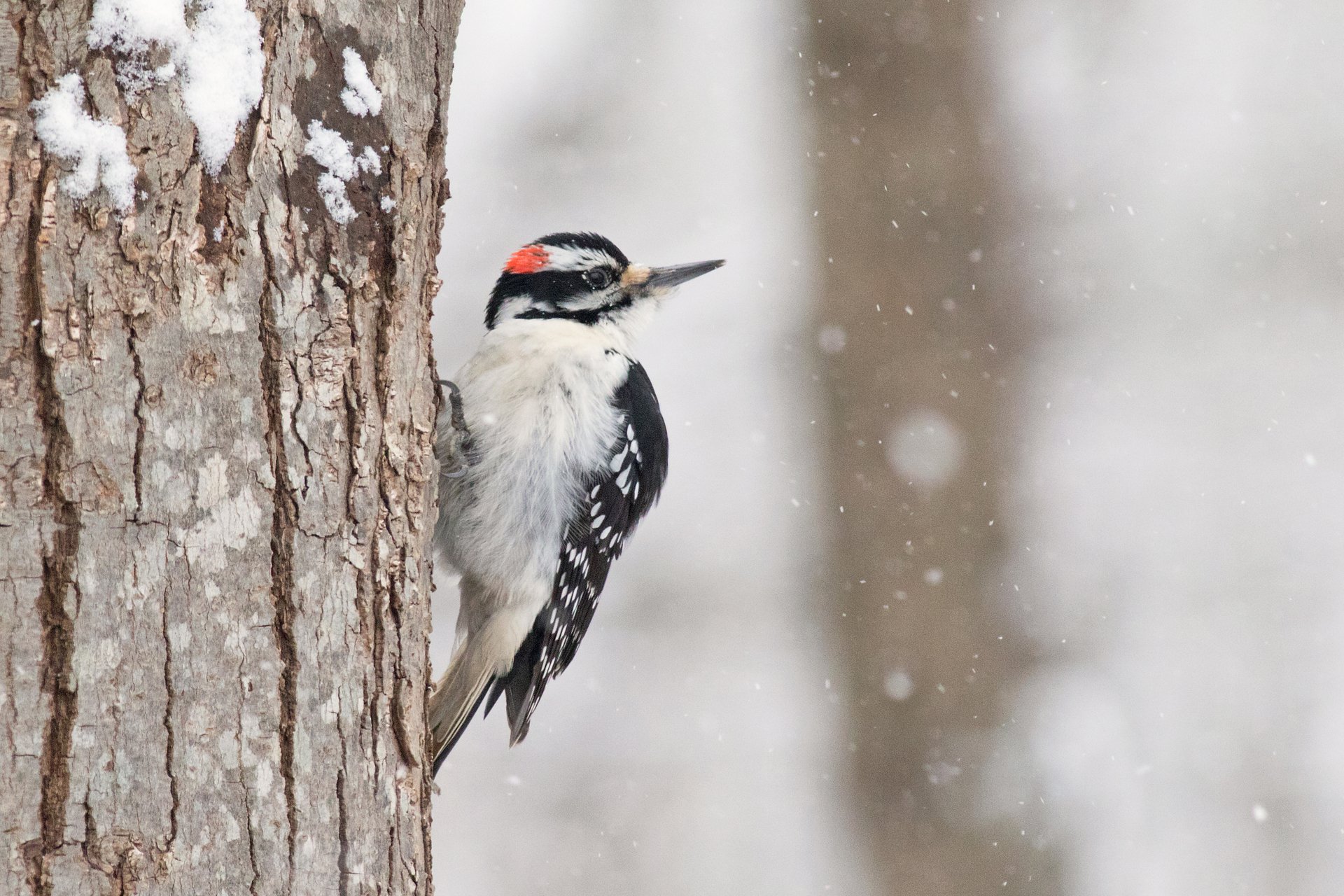
Hairy Woodpecker (Picoides villosus)
The hairy woodpecker prefers mature forests and is less likely to be seen in built-up areas than the downy. It consumes mostly insects with some plant material. This bird and the downy look alike, but the hairy’s beak is larger than the downy’s, and it has all-white outer tail feathers. It makes piercing and rattling calls and drums rapidly on trees.
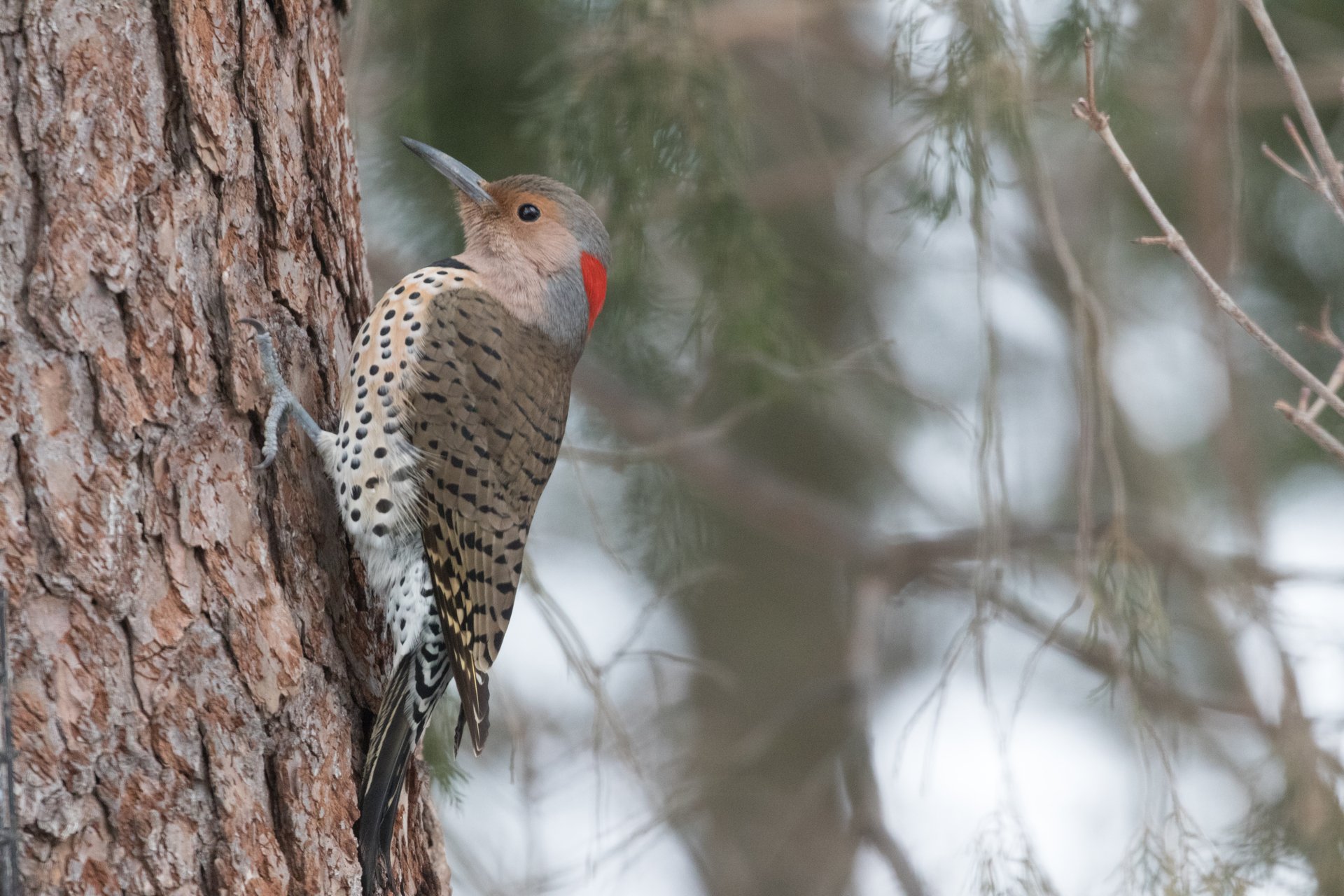
Northern Flicker (Colaptes auratus)
Unlike our other woodpeckers, this species has gray-brown plumage, and its wings flash yellow when it flies. It inhabits woodlands, wetlands, and built-up areas. It eats insects and other invertebrates, as well as seeds and berries. This bird makes piercing single and repetitive calls and drums on trees.

Red-bellied Woodpecker (Melanerpes carolinus)
This bird has only become common in Massachusetts during the past two decades. Despite the name, the most visible area of red on this bird can be found on its head and nape. It is approximately the size of a Hairy Woodpecker and has beige underparts and a black and white barred back. This bird inhabits many types of forests and will visit feeders. Listen for a variety of sounds, from trills to loud chuckles to a steady drumming.
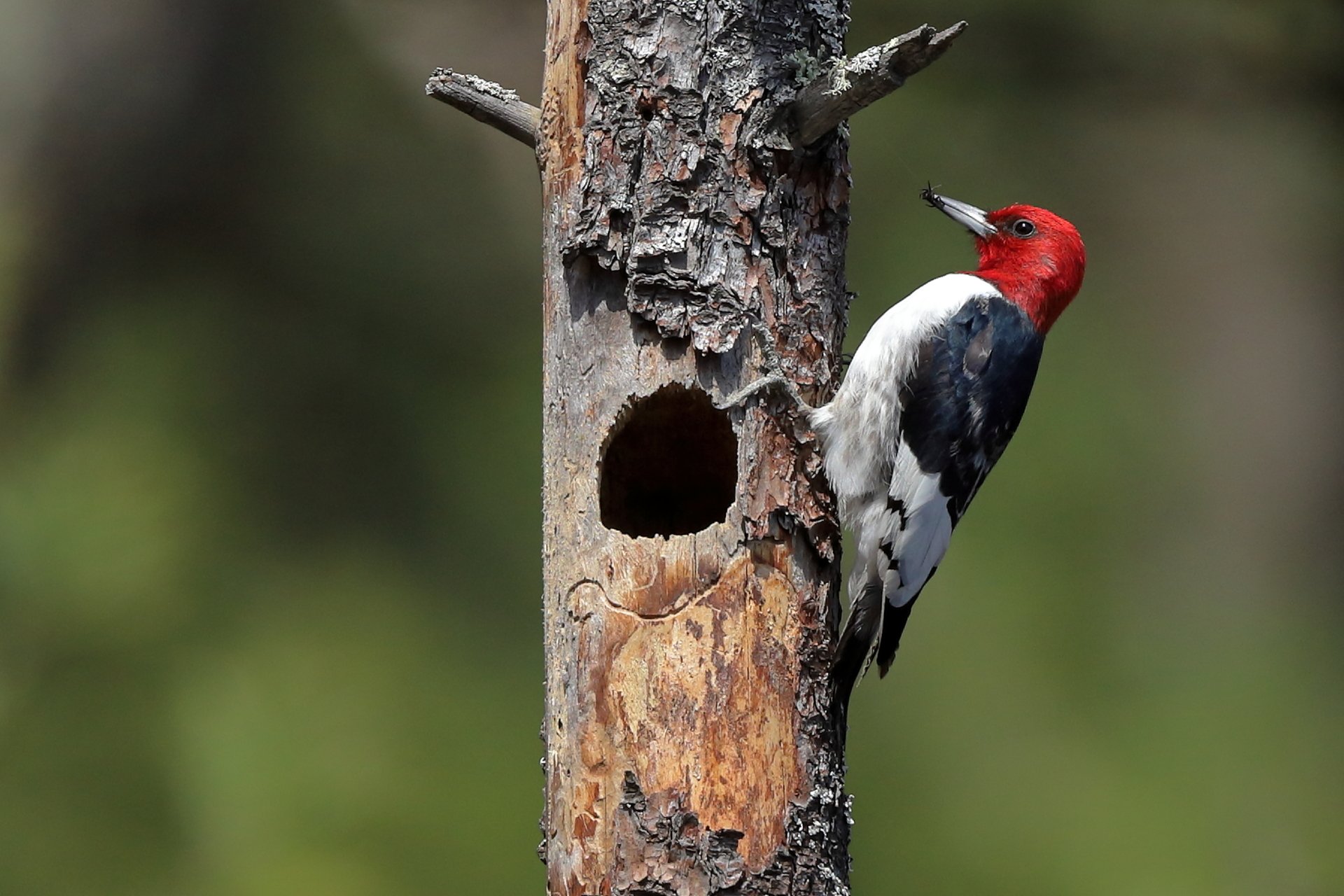
Red-headed Woodpecker (Melanerpes erythrocephalus)
This species breeds only erratically in Massachusetts. The adult has a completely red head, a black back, and a solid white patch on its wings, and the immature has a brown head. This bird has unusual feeding habits for a woodpecker; it stores food in tree crevices, often covering it with bark, and it catches insects in the air. You may hear it drumming relatively slowly on trees.
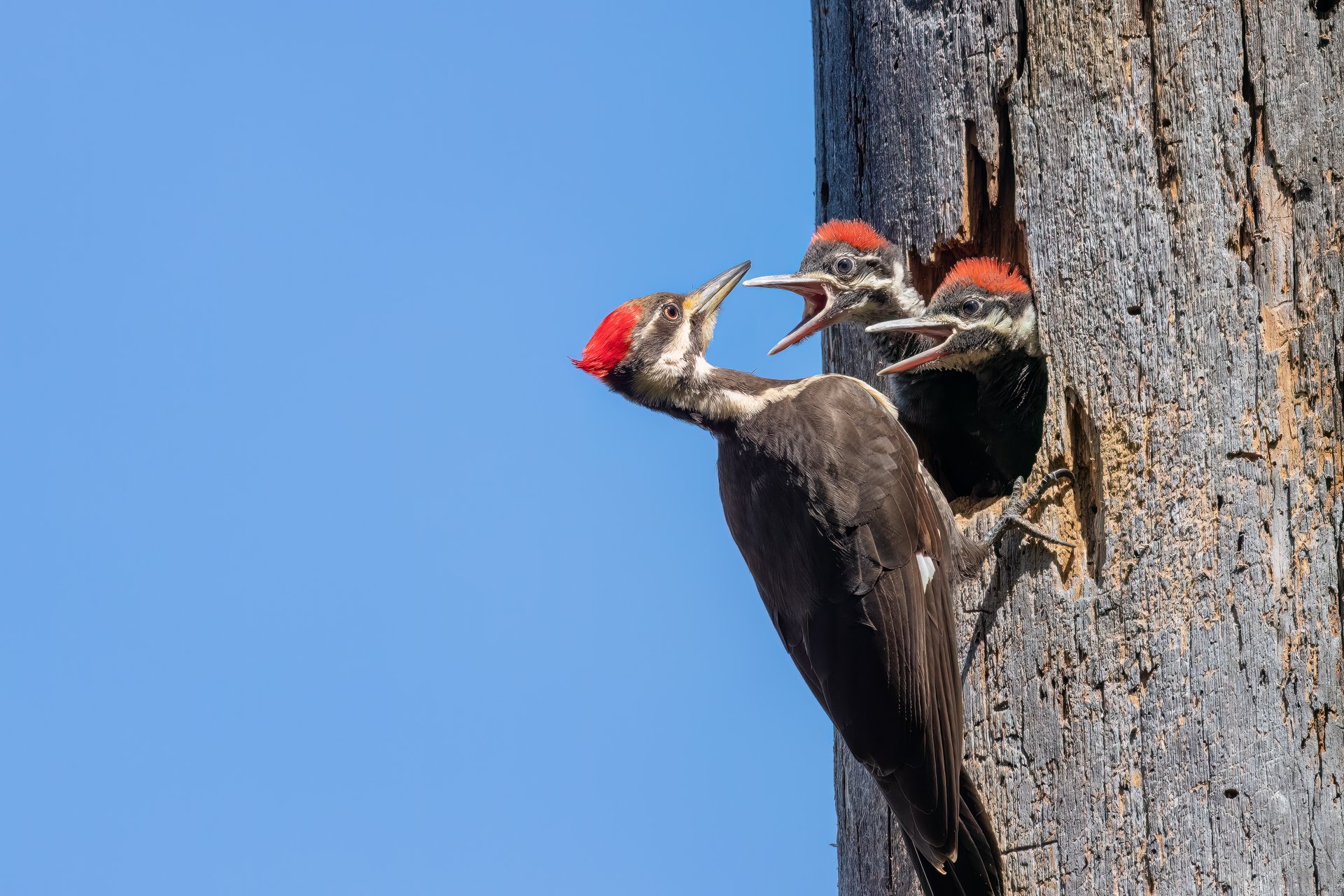
Pileated Woodpecker (Dryocopus pileatus)
The energetic, crow-sized pileated woodpecker is always a remarkable sight. It has a bright red crest and a black body with white patches on its wings. Look for the large rectangular holes that it excavates in trees to find carpenter ants, its preferred food. It makes loud notes and has a repetitive call like a flicker’s, but slower. Listen for a powerful drumming that is slow at first, then speeds up, and then slows again.
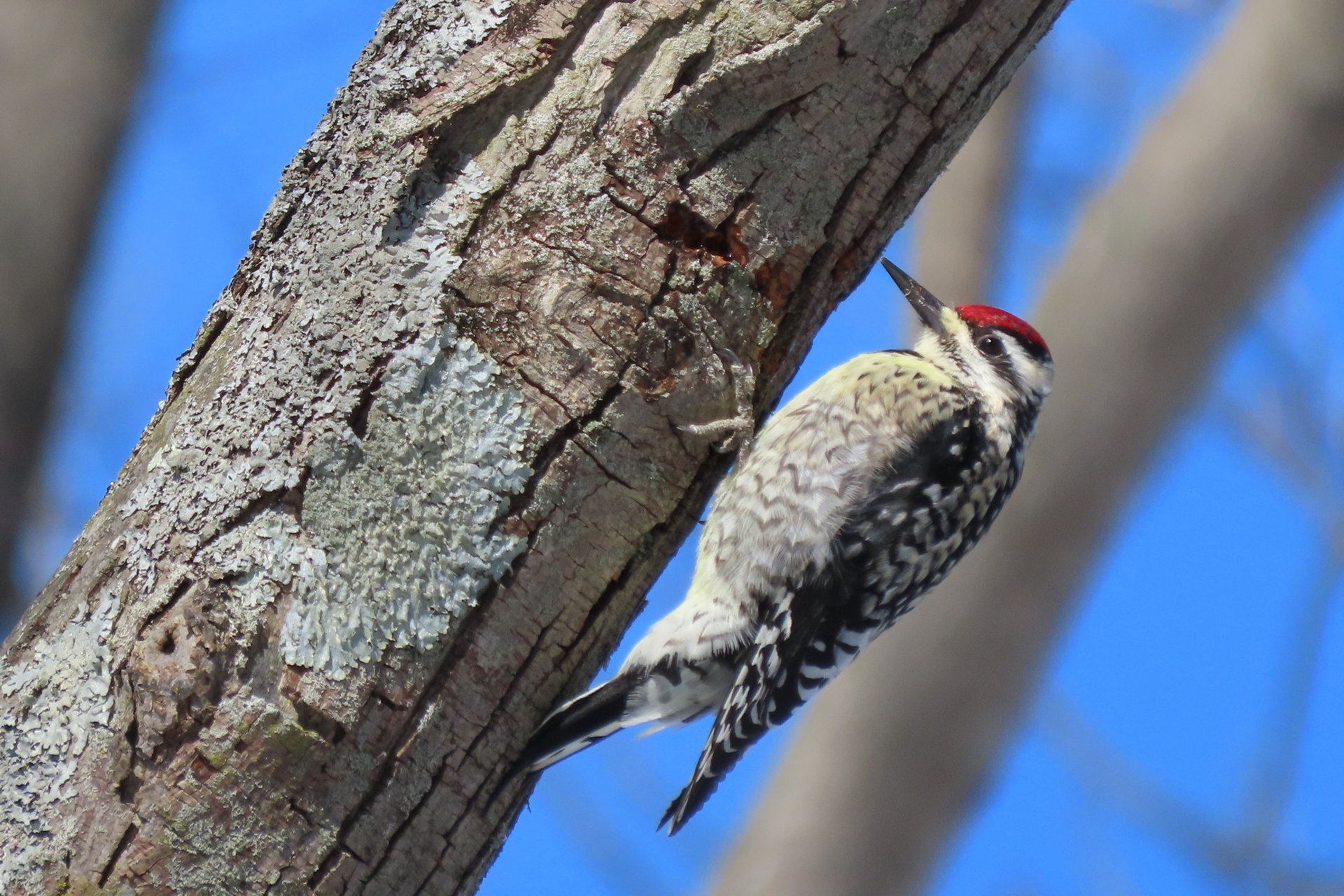
Yellow-bellied Sapsucker (Sphyrapicus varius)
This small woodpecker has a complex black and white pattern, a red forehead (and a red throat in males), and a yellow blush underneath that is often not immediately obvious. It drills rows of small holes around a tree’s trunk from which it sips sap. Listen for repetitive squeaking calls as well as erratic drumming, almost like a person typing on a typewriter. While it only breeds in the western part of Massachusetts, it can be seen throughout the state during migration and occasionally in winter.
Woodpecker Behavior
Woodpecker Life Cycle
Downy and Hairy woodpeckers lay an average of 4-5 eggs in a tree or branch cavity during the month of May. The male and female take turns incubating the eggs (the male brooding at night) for about 12 days. Once offspring have hatched, both parents feed the young for 20-22 days and for another three weeks after offspring leave the nest.
What Do Woodpeckers Eat?
Primarily insectivorous, woodpeckers consume beetles, ants, aphids, flies, and caterpillars. They use their long tongues with bristly tips to extract insects from holes in wood.
Woodpeckers also rely on sound to locate prey. They can hear the rustling and chewing sounds that insects make in the wood. Flickers feed mainly on the ground, often seen hopping about lawns looking for ants. Woodpeckers will also eat acorns, pine seeds, nuts, and berries. The Hairy and Downy Woodpeckers commonly come to feeders for suet and sunflower seeds.
Woodpecker Drillings vs Drumming
When woodpeckers drill, they actually chip out wood and create holes in search of food or to create cavities, potentially sites for nesting or roosting. In the fall, woodpeckers excavate several roosting holes in preparation for the coming winter. In the spring, a resurgence of drilling activity occurs in preparation for the nesting season.
Drumming, on the other hand, is what a woodpecker does to attract a mate or mark its territory by alerting the competition. Drumming occurs most commonly in spring.
How to Deter Woodpeckers
Although woodpeckers serve as beneficial members of the wildlife community, they can come into conflict with people at times. To a woodpecker, a wooden house is simply a large, oddly shaped tree, and the birds frequently choose it as drilling or drumming sites.
Woodpeckers tend to attack homes that are often dark in color (browns and grays) or naturally stained cedar or redwood. Damage usually occurs in shingling or corner posts, and the holes are generally quarter- to half-dollar sized and fairly deep. You may find one to dozens of holes, and the damage can be extensive. Often there is no particular pattern to the placement of the holes. Most of the drilling on houses occurs in the fall (September through November).
While it’s true that woodpeckers drill for insects, it doesn’t mean that you have a harmful infestation of insects. Instead, a drilling woodpecker could be an inexperienced juvenile stressed for food in the fall.
Woodpeckers drilling on homes is seasonal, so in many cases nothing needs to be done. If they are causing significant damage, there are some deterring options:
- Tack a large sheet of plastic, such as a drop cloth or heavy-duty garbage bag, over the wood or metal on your house. Attach the plastic sheet at the top and leave the bottom free to bunch and blow in the wind. The birds won’t be able to get a good footing on the plastic, and the movement of the plastic will help scare them away.
- Try hanging several, six-foot long mylar streamers (found in party supply stores) 10 inches apart over the damaged area to create movement. In hard to reach or inaccessible areas, extend helium-filled mylar balloons (with very long strings) directly in front of the area. Supplement these scare tactics by squirting a hose near the bird before it gets settled in to work in the mornings.
- In corners or under eaves, you can stretch bird netting (i.e., fruit tree netting, available at garden supply centers) so that the woodpecker can’t reach the wood or metal (keep it at least six inches from the surface).
- Leave dead trees and snags around the yard to help provide natural feeding, nesting, and drumming sites for the birds.
Threats Facing Woodpeckers
Like many birds, woodpeckers are threatened by habitat destruction. The Ivory Billed Woodpecker, once native to the Southeastern United States and Cuba, was driven to extinction alongside the loss of mature and old growth forests habitats. The last Ivory Billed Woodpecker was seen in 1944.
How Mass Audubon is Supporting Birds in Massachusetts
Mass Audubon works at our wildlife sanctuaries and beyond to ensure that the nature of Massachusetts continues to thrive. By scientifically monitoring Massachusetts birdlife, Mass Audubon informs important conservation decisions and launches targeted initiatives to help at-risk species. In addition, fostering healthy habitats, supporting native species, and educating people about the importance of nature conservation is critical to our success. Learn more about our work
How You Can Support Birds in Massachusetts
Mass Audubon supports birds like woodpeckers every day, but we couldn’t do it without the support of our 160,000+ members.
Help support woodpeckers, and birds like them, by becoming a member today.
Upcoming Bird Programs
See MoreGrassroots Advocacy for Climate and Nature
-
Online
-
Wednesday, June 11
7:00-8:00pm
Adults & Families - 12 - 17
Rescue Raptors from Rodenticides
-
Online
-
Thursday, June 12
7:00-8:00pm
Adults & Families - 12 - 17
Fair Weather Birding
-
Broadmoor Wildlife Sanctuary, Natick
-
Friday, June 13
7:00-8:30am
Adults
Stay Connected
Don't miss a beat on all the ways you can get outdoors, celebrate nature, and get involved.


